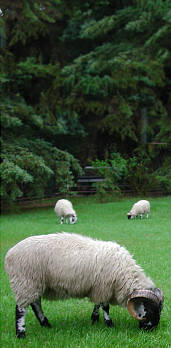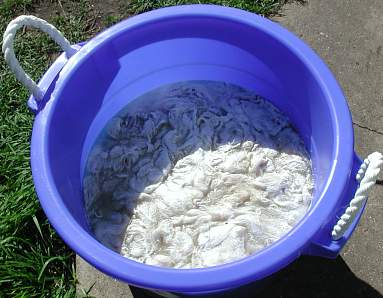
this site last updated Jul 11/08
broken link fixed

PO Box 200 . Amisk, AB . T0B 0B0 (780) 856-3738 mail@nordinfarms.com |
|
How to Wash Your Wool
|
|||
|
|||
|
1
|
Open your fleece and remove any second cuts, tags,
larger bits of vegetable matter, and coarse hairy wool
(such as from around the face or rump).
Note:
If you are working with one of our fleeces, this step has already been done for you, so proceed to step 2. |
||
|
2
|
Into a large bucket such as that pictured below,
pour very hot water mixed with 1/4 cup or more of liquid dish soap.
|
||
|
3
|
Take about half of the fleece at a time and place it in the bucket.
|
||
|
4
|
Push the wool down under the water, making sure that you don't
agitate the wool (which causes it to felt). |
||
|
5
|
Let the wool soak in the hot soapy water for about 20 minutes. |
||

Washing the wool.
|
|||
|
6
|
Drain out the water and any dirt that has sunk to the bottom of the pail.
This can be a bit tricky to do without scalding your fingers, or pouring out your wool with the dirty water. I use a cooling rack -- like what you use to put fresh baked cookies on -- to gently push the wool to the side so the water can be drained off. |
||
|
7
|
If the wool is still dirty you can repeat this process.
Note:
If you are working with one of our fleeces, this should not be necessary. |
||
|
8
|
Put the wet wool into your washing machine and turn it past any
agitation cycle to just the
spin cycle. The machine must not spray water on the fiber either.
The washing machine will spin out the excess water.
|
||
|
9
|
Rince out the bucket and pour in clear hot water mixed
with about 1/2 cup of vinegar to remove any soap residue and rinse
your wool clean.
Note:
If you will not be dyeing your fiber next, but will be spinning it, then use a bit of hair conditioner or fabric softener in the final rinse to give the fiber a softer hand. If you want to dye the fiber after further processing (spinning, felting, etc.), simply wash out the softener before dyeing your yarn. You could also add synthrapol at this point, if called for in the dyeing instructions of your dye manufacturer. Put the wool back into the bucket and carefully push it under the water. |
||
|
10
|
Drain the water off as before and repeat the spin cycle method. |
||
|
11
|
Now lay the damp wool out on a table or rack to air dry. In the summer I put the wool outside on a wire frame and it is dry in no time. | ||
|
|
|||
 |
Your wool is now white and
clean and ready to be used.
To learn more about wool, dying, carding, spinning, weaving, and all the associated tools, check out the excellent categorized resources on our links page. |
|
Washing Wool Garments & Blankets
|
|
Generally, this same method (above) can be used to wash wool garments and
blankets. I have used it to successfully wash blankets, a coat, pants and skirts.
If the garment label says, "Dry clean only" then you likely should, but you may proceed to hand-wash your item (as I did) at your own risk. Select a washing container according to the size of the item you want to wash -- a bathtub will do for large items.
Caution:
When washing a wool coat or garment that includes other material besides wool (such as an acetate lining), first test an inconspicuous spot on the other material to ensure it won't run. Then follow the method listed above, but use cold or warm water (as opposed to hot) to prevent heat shrinking any synthetic fabric. After washing, air dry flat. You will also need to re-shape the garment both immediately, and possibly during drying to ensure proper fit and straight hems. Some ironing may also be required (again, check the other material first). Stains may require spot cleaning prior to washing the garment. |